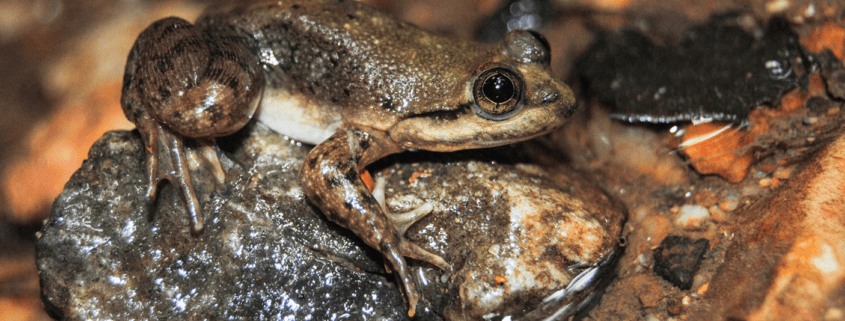Endangered Species Refuge in Ghana Expanded
In Ghana’s southeast, in the hills along the border with Togo, sits a series of forest patches. Surrounding these forests are human settlements, farms and savannas — which isolate this area from other West African forests. Due to this isolation and heavy human influence, most of the species once native to these forests, like Chimpanzees, have long since disappeared.
Yet if you head into these forests at night, along the rushing creeks and under the dense trees, you might hear a sharp whistle shoot out of the darkness. You can search the riverbanks and stones for a glimpse of whatever made this noise, but unless you know exactly what you’re looking for, it’ll probably see you and hide underwater before you spot it.
The originator of this haunting nocturnal call is the Critically Endangered Togo Slippery Frog. In 2018, Rainforest Trust and Herp Conservation Ghana, a local amphibian-focused conservation non-profit, and the local communities first created the 847-acre Onepone Endangered Species Refuge to protect the species. And, as of this month, the reserve has officially more than doubled in size to 2,132 acres.

The Critically Endangered Togo Slippery Frog. Photo courtesy of Herp Conservation Ghana.
After working with Herp Conservation Ghana’s team on the ground, the local district assembly has voted to approve expanding the protected area. And this action will do more than protect the Togo Slippery Frog. Other species in the area include the Critically Endangered Hooded Vulture and Vulnerable Ukami Reed Frog. At least 151 other bird species and 18 other amphibian species live in these forests as well, alongside mammals like Black-bellied and White-bellied Pangolins.
The local community is heavily involved in reserve management and planning. Volunteers from the two nearest communities, Amedzofe and Gbadzeme, visit churches to speak about the benefits of forest conservation and plan activities like hikes, dance competitions and poetry slams to raise awareness. They also work on ecological restoration to help speed along forest regrowth in deforested areas. Herp Conservation Ghana’s team also works with local farmers and hunters to encourage sustainable practices.
“I am excited that I have lived to see this day. A day when people have agreed to live peacefully together with wildlife,” said Caleb Ofori-Boateng, founder of Herp Conservation Ghana. “This work would not have been possible without the partnership and financial support of Rainforest Trust and our other partners. We are proud of the local people and the government of Ghana at the regional level for strongly supporting forest and wildlife conservation.”
“This new reserve gives us hope,” Caleb continued. “Hope for 11 IUCN threatened species who have a fighting chance to survive with expansion of the reserve and again hope in humanity that we can still work together to make the world a better place.”

Caleb Ofori-Boateng, founder of Herp Conservation Ghana, inspects a Togo Slippery Frog. Photo courtesy of Herp Conservation Ghana.
“The Onepone Endangered Species Refuge should be a model for community-centered conservation,” said James Lewis, Rainforest Trust’s Africa Conservation Director. “By placing the community at the center of this process, they’ve brought success and ownership of conservation work to everyone involved.”
This expansion is another success in this community-centered project for a highly threatened amphibian species. The team on the ground will place pillars to mark the new boundaries of the reserve and continue outreach to nearby landowners. Researchers have already been on site in the new land to learn more about resident bird, plant and amphibian communities.
To learn more about this project, visit the project page.
This project was made possible through gifts to the Conservation Action Fund. All donations were matched by SAVES Challenge.
Header image: The Critically Endangered Togo Slippery Frog. Photo by Michael Akrasi.





